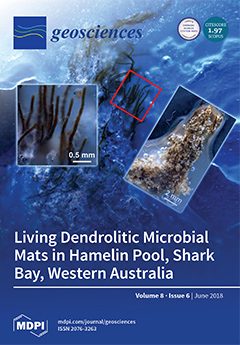Crescent-shaped barchan dunes often display an asymmetric shape, with one limb longer than the other. As shown in previous studies, asymmetric bimodal winds constitute one major cause of barchan asymmetry, but the heterogeneous conditions of sand availability or flux, as well as topographic
[...] Read more.
Crescent-shaped barchan dunes often display an asymmetric shape, with one limb longer than the other. As shown in previous studies, asymmetric bimodal winds constitute one major cause of barchan asymmetry, but the heterogeneous conditions of sand availability or flux, as well as topographic influences, may be also important. Understanding the morphology and dynamics of asymmetric barchans may have an impact in a broad range of areas, particularly as these dunes may serve as a proxy for planetary wind regimes and soil conditions in extraterrestrial environments. However, in addition to the existing theories and numerical models that explain barchan asymmetry, direct measurements of migration rates and morphologic changes of real asymmetric barchans over a time span of several years would be beneficial. Therefore, here we report such measurements, which we have acquired by investigating asymmetric barchans in the Hexi Corridor, northwest of China. We have found that dune interactions and asymmetric influx conditions are the most important causes of barchan asymmetry in this field. Particle size distributions in the Hexi Corridor display strong variations over different parts of the asymmetric barchans, as well as over different dunes, with gravel particles being incorporated from the substrate as the dunes migrate. Our observations have shown that upwind sediment sources are important for dune formation in the Hexi Corridor, and that interdune interactions affect dune shape in different ways, depending on their offset. The asymmetric barchans in the Hexi Corridor are active, with an average migration rate (
MR) between 8 and 53 m year
−1, in spite of the different asymmetric shapes. Our data for dune migration rates can be described well by a scaling of
MR =
A/(
W +
W0), where
W is the barchan cross-wind width,
A ≈ 2835 m
2 s
−1, and
W0 ≈ 44 m. A similar scaling fits very well the migration rate as a function of dune along-wind width
L, (i.e.,
MR =
B/(
L +
L0), with
B ≈ 1722 m
2 s
−1 and
L0 ≈ 13 m). Linear relations are also found between both dune widths and the average limb and windward side lengths, thus indicating that the morphometric relations that are predicted from models for steady-state, symmetric crescent-shaped dunes can be applied to different transitional morphologies of interacting, asymmetric barchans.
Full article





